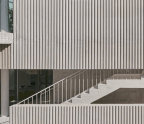MISE-EN-SCÈNE OF PHYSICAL PROPERTIES AND CONSTRUCTION

Physical Properties and Relationships
In the 1960s, the art movement known as Minimalism emerged in the United States. It attempted to eliminate unnecessary matters and leave only minimal needs.
In opposition to the rules of visuality and the flatness of painting, it pursued a conceptual art and other art practices that deny flatness. Artists such as Frank Stella and Richard Serra pursued new works of art that would focus on the sensations that occur when encountering objects, the perception of time and space, and the behavior of recognizing the relationships. With Japanese artists as the central figures, Mono-ha (School of Things) explored the stimulus presented by the physical properties of objects such as soil, wood, glass, water and steel, and also the encounters with industrial materials, minimizing the act of processing while pursuing an art based on relationships with its surroundings.
In the art world, the resistance against the modern view of nature in the West – such as the 1968 student movement in Europe – was achieved by various means, and the emergence of metabolism and postmodernism in architecture is not irrelevant to this emergent political trend. Instead of using the word ‘creation’ to describe the work, it was the time 1) to work as a ‘presenter’ who would present something that already exists with a different perspective, or 2) to move on from the simple representation to presentation of a new relationship in architecture and artwork — like Reyner Banham’s (1981) and Christopher Alexander’s (1977). Lately, after seeing the works of Quac Insik, the architecture of Itami Jun, and the works of Mono-ha artists at Gwacheon National Museum of Modern and Contemporary Art, I was able to think back over the projects and sketches, and traces of the skull and sculptural work by Cho Byoungsoo –whom I met in University of Cambridge in 1989 and with whom I spent time in the studio, in Peabody terrace, and the college accommodation.
You’re reading a preview, subscribe to read more.
Start your free 30 days

